display TOYOTA RAV4 EV 2014 1.G Owner's Guide
[x] Cancel search | Manufacturer: TOYOTA, Model Year: 2014, Model line: RAV4 EV, Model: TOYOTA RAV4 EV 2014 1.GPages: 521, PDF Size: 7.44 MB
Page 176 of 521
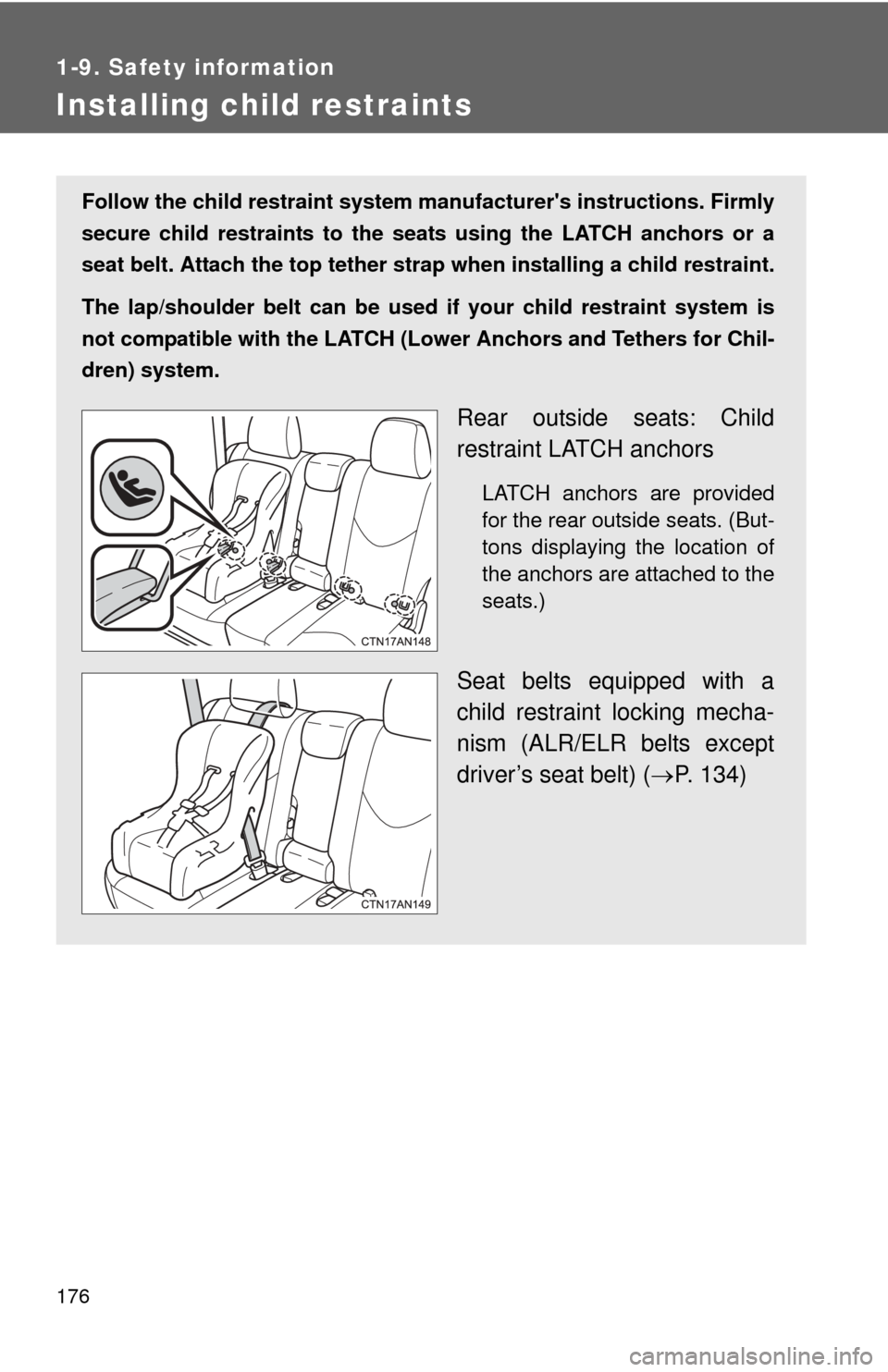
176
1-9. Safety information
Installing child restraints
Follow the child restraint system manufacturer's instructions. Firmly
secure child restraints to the seat s using the LATCH anchors or a
seat belt. Attach the top tether stra p when installing a child restraint.
The lap/shoulder belt can be used if your child restraint system is
not compatible with the LATCH (Low er Anchors and Tethers for Chil-
dren) system.
Rear outside seats: Child
restraint LATCH anchors
LATCH anchors are provided
for the rear outside seats. (But-
tons displaying the location of
the anchors are attached to the
seats.)
Seat belts equipped with a
child restraint locking mecha-
nism (ALR/ELR belts except
driver’s seat belt) ( P. 134)
Page 189 of 521
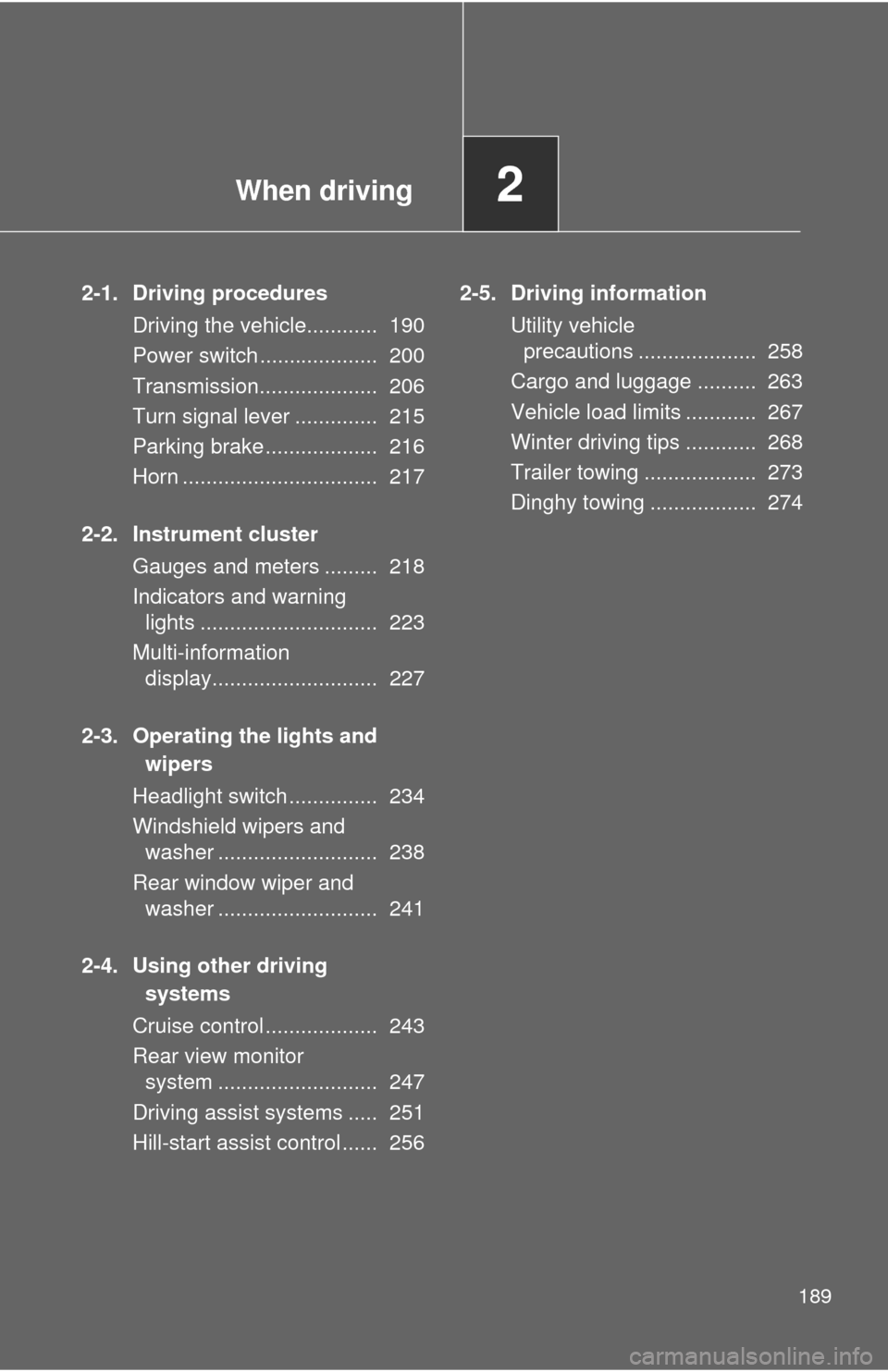
When driving2
189
2-1. Driving proceduresDriving the vehicle............ 190
Power switch .................... 200
Transmission.................... 206
Turn signal lever .............. 215
Parking brake ................... 216
Horn ................................. 217
2-2. Instrument cluster Gauges and meters ......... 218
Indicators and warning lights .............................. 223
Multi-information display............................ 227
2-3. Operating the lights and wipers
Headlight switch ............... 234
Windshield wipers and washer ........................... 238
Rear window wiper and washer ........................... 241
2-4. Using other driving systems
Cruise control ................... 243
Rear view monitor system ........................... 247
Driving assist systems ..... 251
Hill-start assist control ...... 256 2-5. Driving information
Utility vehicle precautions .................... 258
Cargo and luggage .......... 263
Vehicle load limits ............ 267
Winter driving tips ............ 268
Trailer towing ................... 273
Dinghy towing .................. 274
Page 195 of 521
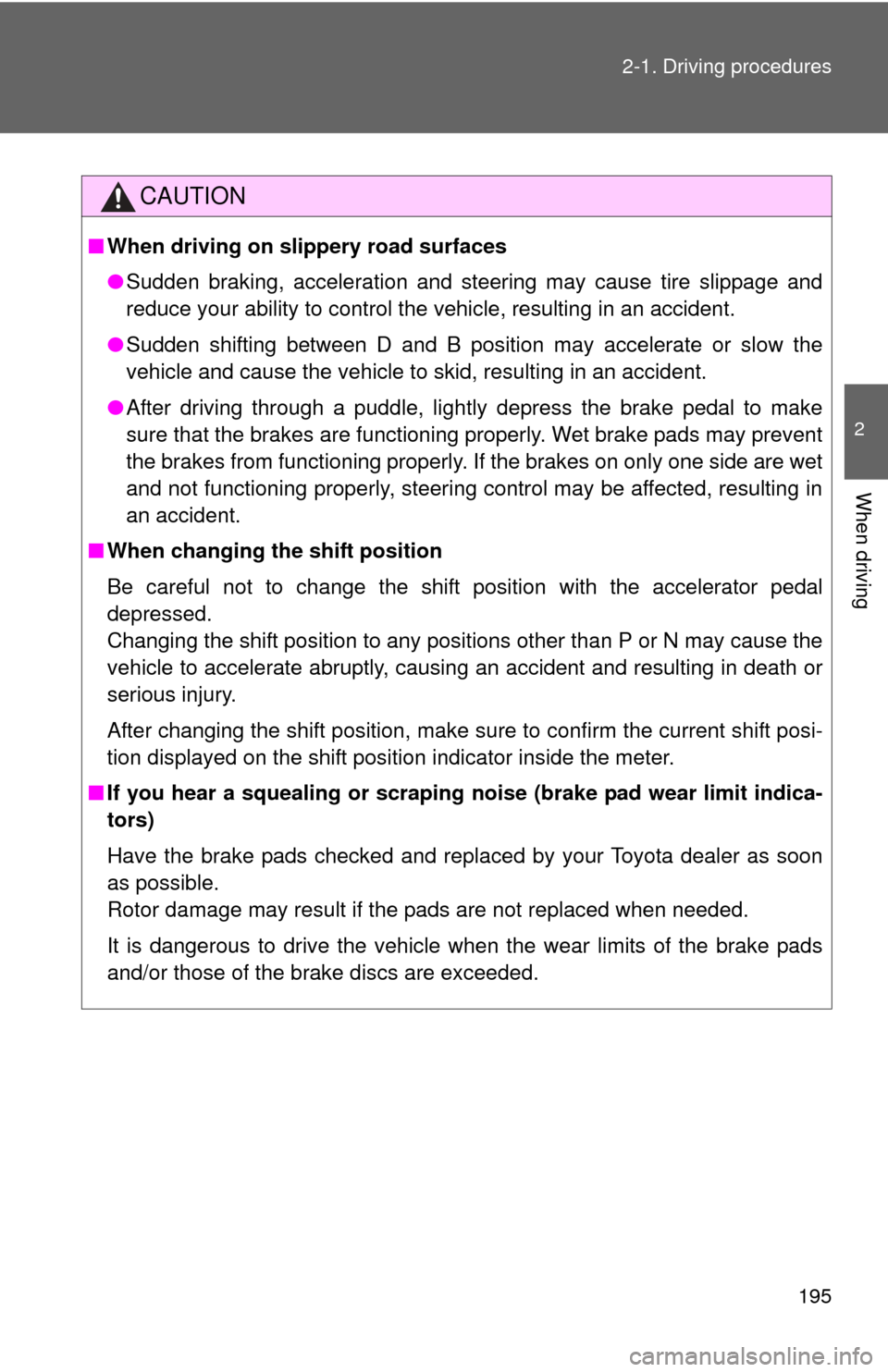
195
2-1. Driving procedures
2
When driving
CAUTION
■
When driving on slippery road surfaces
●Sudden braking, acceleration and steering may cause tire slippage and
reduce your ability to control the vehicle, resulting in an accident.
● Sudden shifting between D and B position may accelerate or slow the
vehicle and cause the vehicle to skid, resulting in an accident.
● After driving through a puddle, lightly depress the brake pedal to make
sure that the brakes are functioning properly. Wet brake pads may prevent
the brakes from functioning properly. If the brakes on only one side are wet
and not functioning properly, steering control may be affected, resulting in
an accident.
■ When changing the shift position
Be careful not to change the shift position with the accelerator pedal
depressed.
Changing the shift position to any positions other than P or N may cause the
vehicle to accelerate abruptly, causing an accident and resulting in death or
serious injury.
After changing the shift position, make sure to confirm the current shift posi-
tion displayed on the shift position indicator inside the meter.
■ If you hear a squealing or scraping noise (brake pad wear limit indica-
tors)
Have the brake pads checked and replaced by your Toyota dealer as soon
as possible.
Rotor damage may result if the pads are not replaced when needed.
It is dangerous to drive the vehicle when the wear limits of the brake pads
and/or those of the brake discs are exceeded.
Page 201 of 521
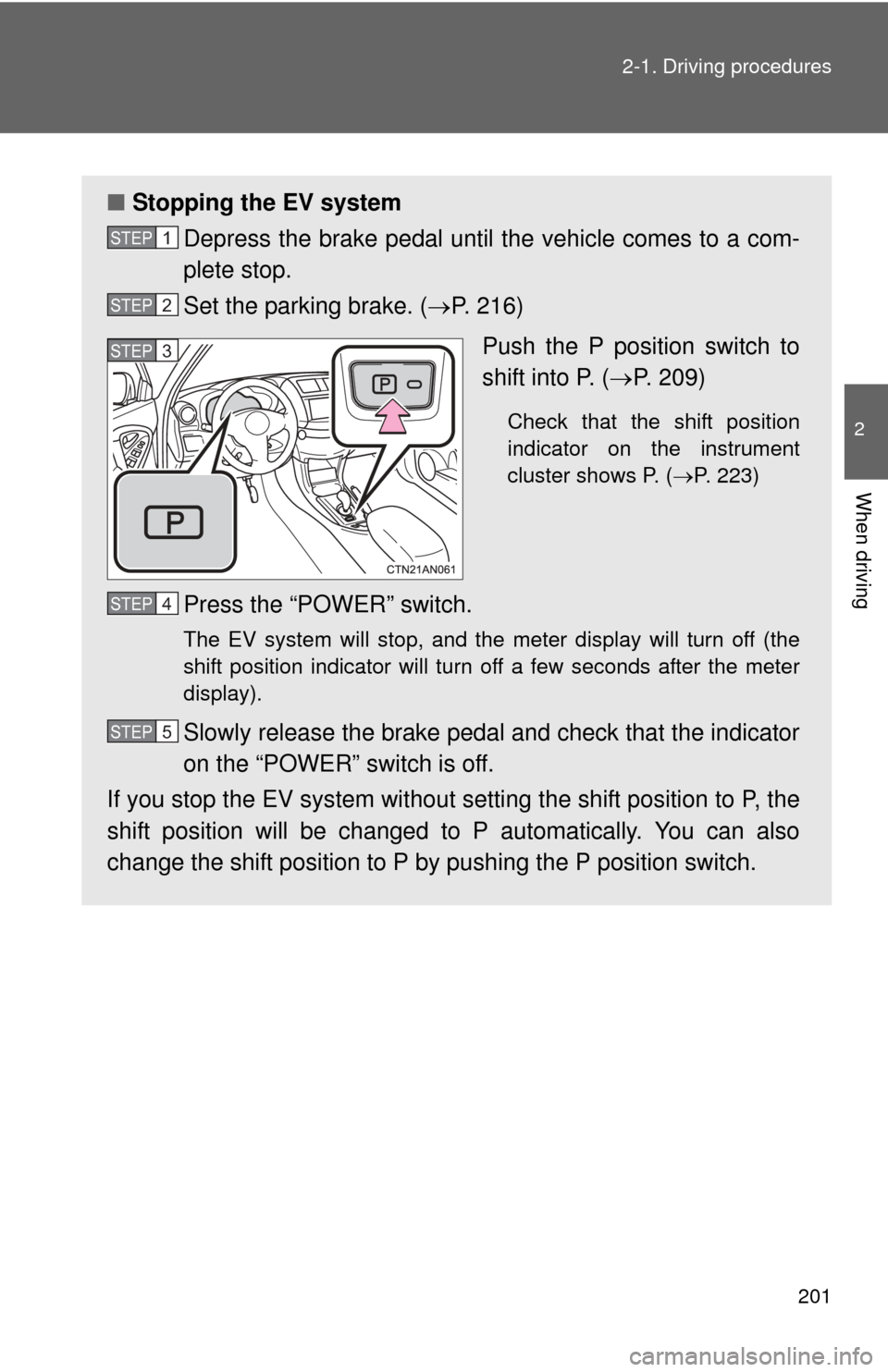
201
2-1. Driving procedures
2
When driving
■
Stopping the EV system
Depress the brake pedal until the vehicle comes to a com-
plete stop.
Set the parking brake. ( P. 216)
Push the P position switch to
shift into P. ( P. 209)
Check that the shift position
indicator on the instrument
cluster shows P. ( P. 223)
Press the “POWER” switch.
The EV system will stop, and the meter display will turn off (the
shift position indicator will turn off a few seconds after the meter
display).
Slowly release the brake pedal and check that the indicator
on the “POWER” switch is off.
If you stop the EV system without setting the shift position to P, the
shift position will be changed to P automatically. You can also
change the shift position to P by pushing the P position switch.
STEP 1
STEP 2
STEP 3
STEP 4
STEP 5
Page 203 of 521

203
2-1. Driving procedures
2
When driving
■
Auto power off function
If the vehicle is left in ACCESSORY mode for more than an hour with the
shift position in P, the “POWER” switch will automatically turn off.
■ Sounds and vibrations specific to a electric vehicle
P. 3 0
■ Electronic key battery depletion
P. 106
■ Auto P position function
●If the “POWER” switch is pressed while the EV system is operating and
the vehicle is at a complete stop, the “POWER” switch will be turned to
OFF, then the shift position will be automatically switched to P.
When turning the “POWER” switch to off while the shift position is not set
to P, operate the “POWER” switch while pushing down fully on the brake
pedal. Then, release the brake pedal after confirming that the shift posi-
tion indicator on the instrument cluster shows P.
● If the auto P position function is malfunctioning, it may not be possible to
turn the “POWER” switch to off. In this event, the “POWER” switch can
be turned to off after applying the parking brake.
Have the vehicle inspected by your Toyota dealer immediately.
■ When the ambient temperature is low, such as during winter driving
conditions
Driving power may be limited due to traction battery temperature being low.
Follow the instructions on the meter display. If the vehicle has been parked
for a long time in low ambient temperatures, it may be necessary to plug in
the vehicle to warm-up and charge the traction battery before driving.
■ When the P position cont rol system malfunctions
The “POWER” switch will not be able to be turned off. In such a case, the
switch can be turned off after applying the parking brake.
Have the vehicle inspected by your Toyota dealer immediately.
■ Conditions affecting operation
P. 104
■ Note for the entry function
P. 105
Page 204 of 521
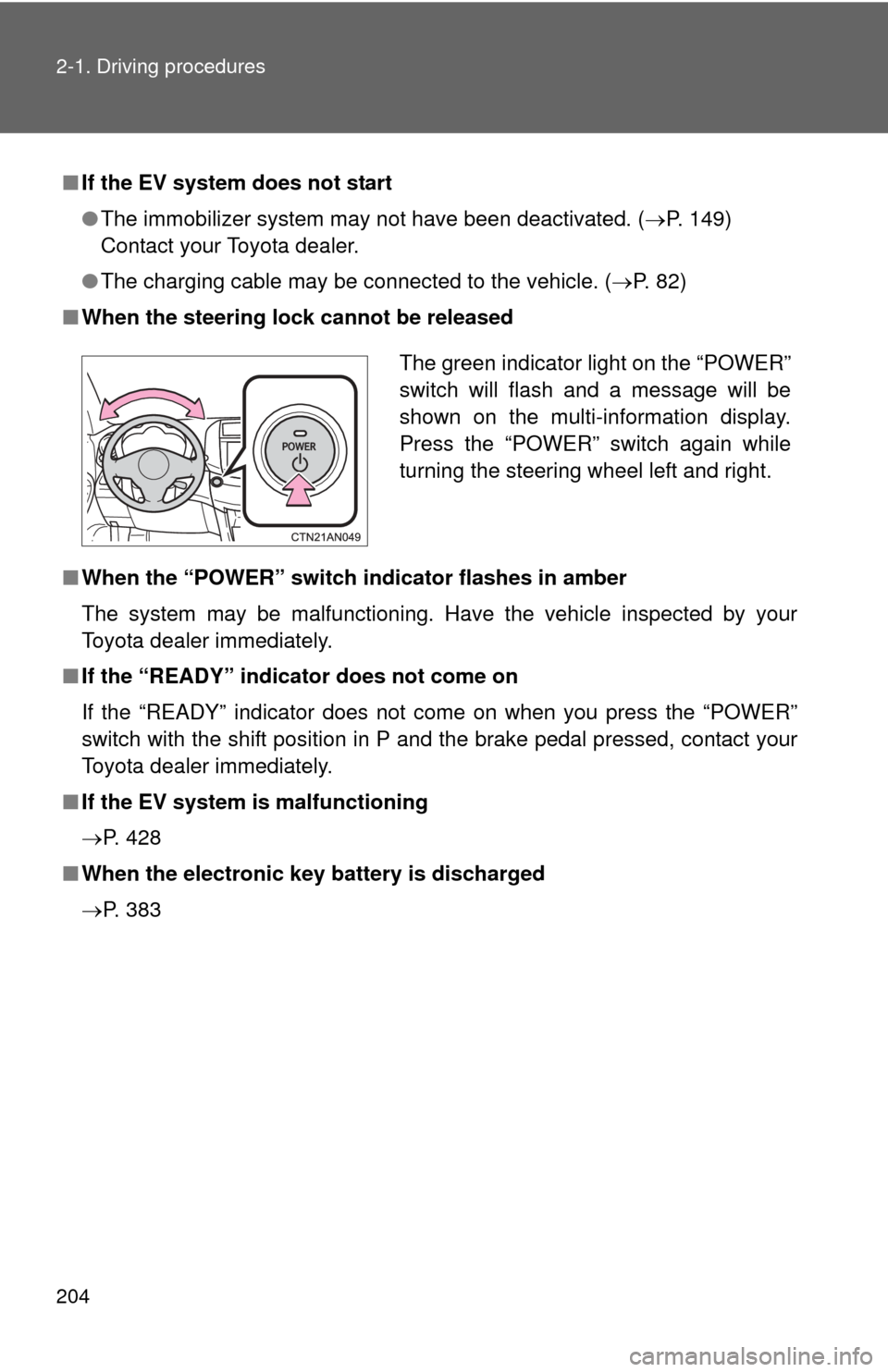
204 2-1. Driving procedures
■If the EV system does not start
●The immobilizer system may not have been deactivated. ( P. 149)
Contact your Toyota dealer.
● The charging cable may be connected to the vehicle. ( P. 82)
■ When the steering lock cannot be released
■ When the “POWER” switch in dicator flashes in amber
The system may be malfunctioning. Have the vehicle inspected by your
Toyota dealer immediately.
■ If the “READY” indicator does not come on
If the “READY” indicator does not come on when you press the “POWER”
switch with the shift position in P and the brake pedal pressed, contact your
Toyota dealer immediately.
■ If the EV system is malfunctioning
P. 428
■ When the electronic key battery is discharged
P. 383
The green indicator light on the “POWER”
switch will flash and a message will be
shown on the multi-information display.
Press the “POWER” switch again while
turning the steering wheel left and right.
Page 208 of 521
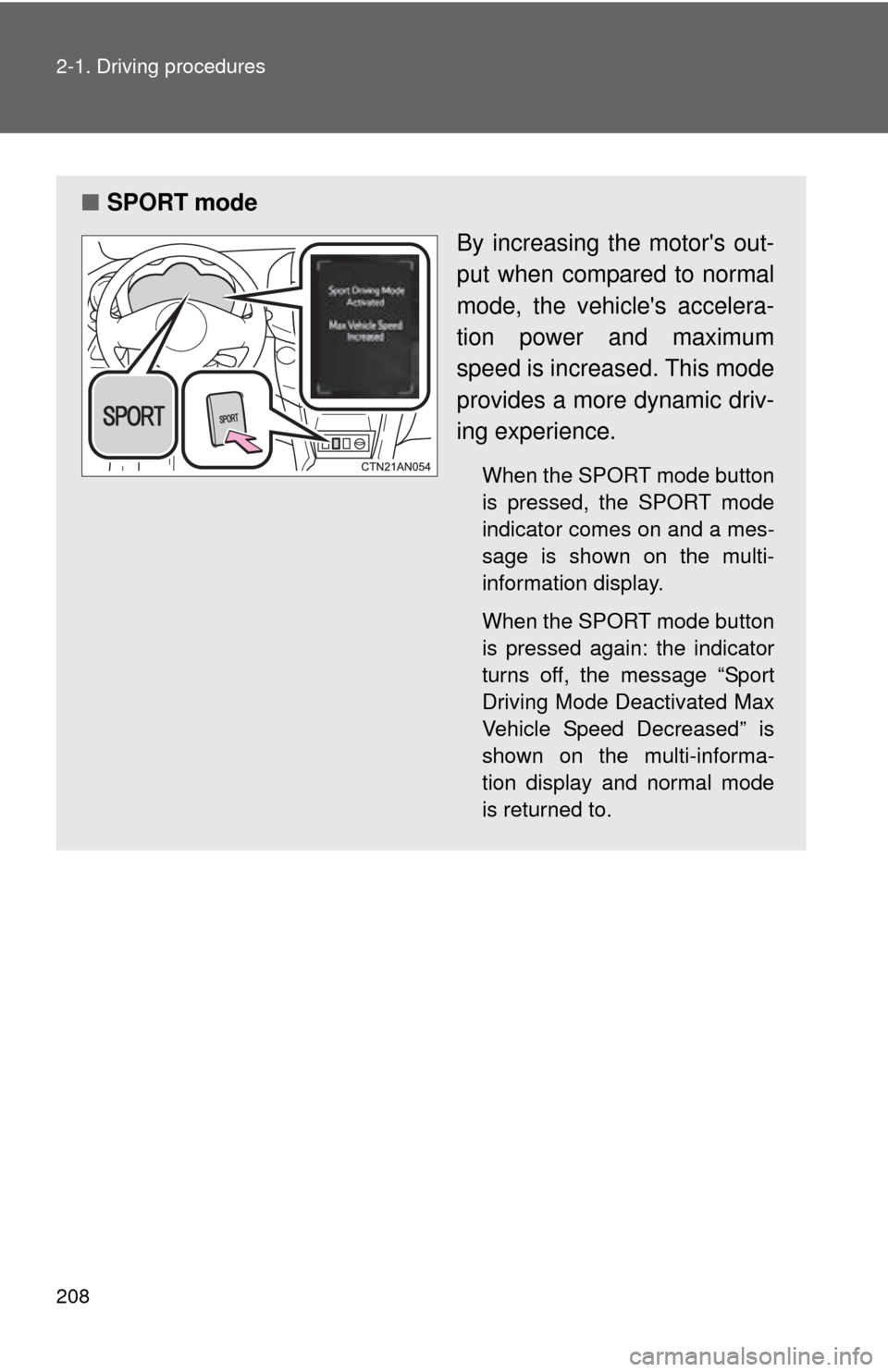
208 2-1. Driving procedures
■SPORT mode
By increasing the motor's out-
put when compared to normal
mode, the vehicle's accelera-
tion power and maximum
speed is increased. This mode
provides a more dynamic driv-
ing experience.
When the SPORT mode button
is pressed, the SPORT mode
indicator comes on and a mes-
sage is shown on the multi-
information display.
When the SPORT mode button
is pressed again: the indicator
turns off, the message “Sport
Driving Mode Deactivated Max
Vehicle Speed Decreased” is
shown on the multi-informa-
tion display and normal mode
is returned to.
Page 211 of 521

211
2-1. Driving procedures
2
When driving
■
Reverse warning buzzer
When shifting into R, a buzzer will sound to inform the driver that the shift
position is in R.
■ Automatically P position selection function
When the “POWER” switch is in ON mode while the shift position is in a
position other than P and the vehicle is stopped completely, pressing the
“POWER” switch will cause the automatic P position selection function to
operate together with the “POWER” switch being turned to off.
■ If the shift position cannot be shifted from P
There is a possibility that the 12-volt battery is discharged. Check the 12-volt
battery in this situation. ( P. 470)
■ Using regenerative braking
When shift position D or B is selected, releasing the accelerator pedal will
apply regenerative braking.
The vehicle can be accelerated even when shift position B is selected.
If the brake pedal is depressed very quickly after the accelerator pedal is
released, the amount of regenerated energy displayed on the EV system
indicator ( P. 221) may be less than expected. This is not a malfunction,
and will probably not feel any different than usual. The amount of regener-
ated energy will return to expected when the brake pedal is released and
depressed again.
■ If the system malfunctions
The following situations indicate a problem with the system.
Immediately stop the vehicle in a safe place and contact your Toyota dealer.
●All frames of the shift position indicators in the instrument cluster flash.
● The parking system error message appears on the multi-information dis-
play.
● The instrument cluster does not come on when the “POWER” switch is in
ON mode.
Page 212 of 521
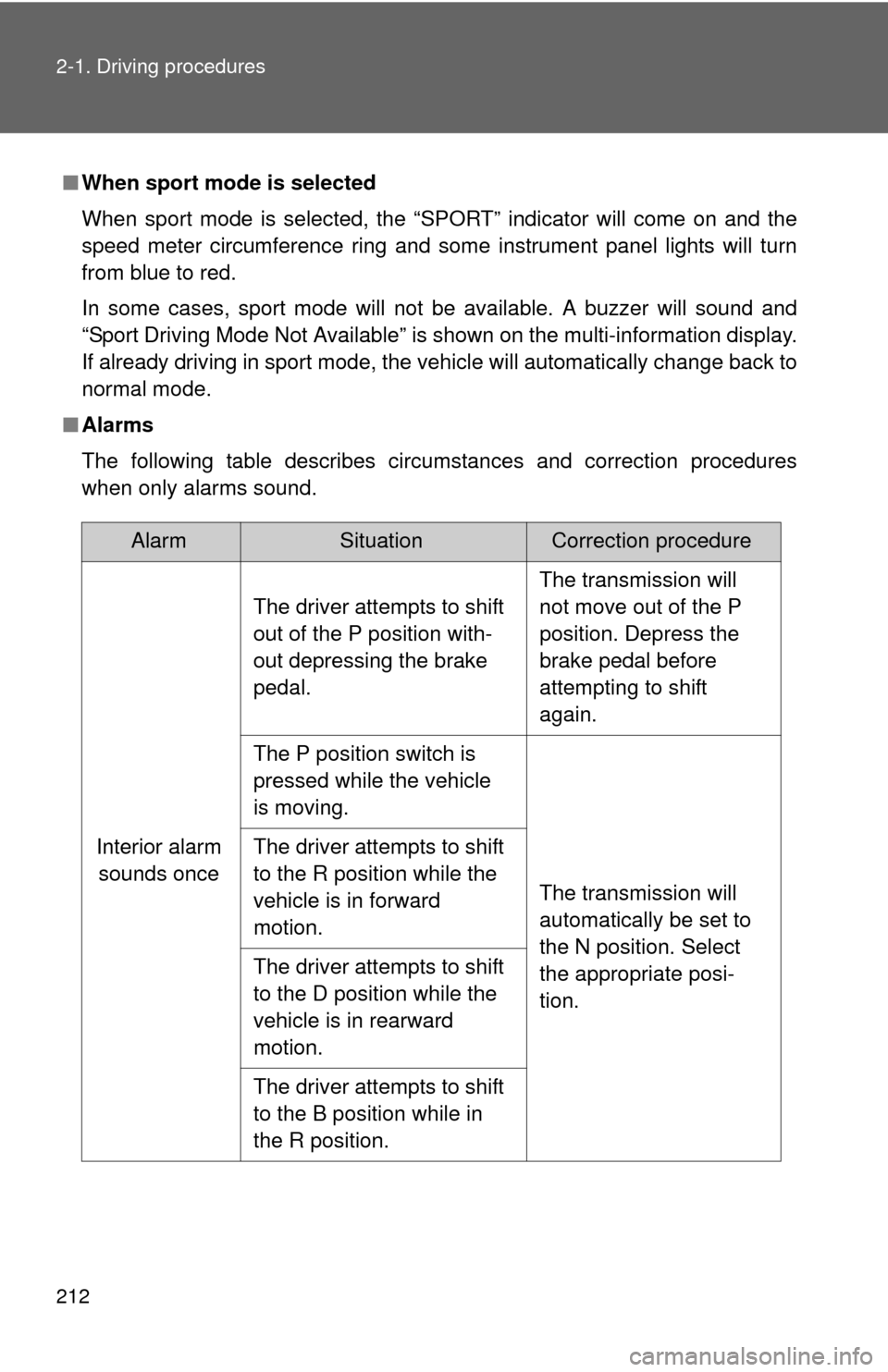
212 2-1. Driving procedures
■When sport mode is selected
When sport mode is selected, the “SPORT” indicator will come on and the
speed meter circumference ring and some instrument panel lights will turn
from blue to red.
In some cases, sport mode will not be available. A buzzer will sound and
“Sport Driving Mode Not Available” is shown on the multi-information display.
If already driving in sport mode, the vehicle will automatically change back to
normal mode.
■ Alarms
The following table describes circumstances and correction procedures
when only alarms sound.
AlarmSituationCorrection procedure
Interior alarm sounds once The driver attempts to shift
out of the P position with-
out depressing the brake
pedal.
The transmission will
not move out of the P
position. Depress the
brake pedal before
attempting to shift
again.
The P position switch is
pressed while the vehicle
is moving.
The transmission will
automatically be set to
the N position. Select
the appropriate posi-
tion.
The driver attempts to shift
to the R position while the
vehicle is in forward
motion.
The driver attempts to shift
to the D position while the
vehicle is in rearward
motion.
The driver attempts to shift
to the B position while in
the R position.
Page 213 of 521

213
2-1. Driving procedures
2
When driving
*: Follow the warning message displayed.
AlarmSituationCorrection procedure
Interior alarm sounds once The driver attempts to shift
to the B position while in
the P or N position.
The transmission will
not move out of the P or
N position. Select the
appropriate position.
The driver attempts to shift
from P position to another
position during charging. The transmission will
not move out of the P
position. Disconnect
the charging cable,
start the EV system,
and shift again.
Interior alarm beep sounds and warning message
*
If the driver’s door is
opened while the transmis-
sion is in N, D or B. Push the P position
switch.